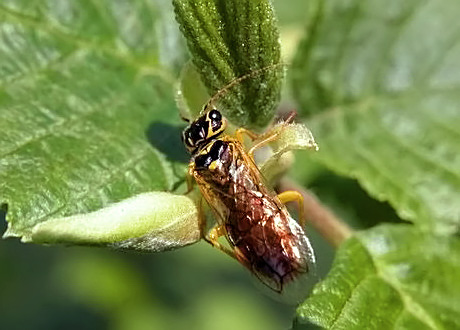Pests
Neurotoma nemoralis L. - European Cherry Webspinning Sawfly
Synonyms.
Pamphilius nemoralis L., Tenthredo nemoralis L.Systematic position.
Class Insecta, order Hymenoptera, suborder Symphyta, family Pamphiliidae, genus Neurotoma.Biological group.
Pest of horticultural crops.Morphology and biology.
Adult is 7-10 mm long; body is black with white spots on the head and sides of abdomen. Legs are yellow with blackened bases. Wings are entirely transparent. Antennae are black with 20 to 21 segments. In females, antennae are as long as abdomen; in males, they are equal in length to thorax and abdomen combined. Eggs are oblong oval, yellowish-white. Larvae are 15 mm in size, deep-green with a black head and a dark stripe on the dorsal side. Larvae overwinter in soil cocoons at a depth of 20-25 cm and pupate in spring. Adults emerge in April when cherry foliage blossoms out; their flight lasts two months. Females lay 70 eggs in a line or in groups on leaf underside. Hatched larvae fasten the young leaves by web and skeletonize them. The larvae form a colony in a large web nest which retains leaf remnants and excrements. They feed for a month and then abandon the tree crown to hibernate. Usually it occurs at the end of June or in early July. Some larvae do not pupate and hibernate repeatedly if drought occurs.Distribution.
The species is found in South Sweden, Denmark, Central Europe, Baltic States, Italy, Hungary, Romania, Northern Caucasus, Turkey, Kazakhstan, middle and southern areas of the European part of the former USSR, in Southwestern Siberia. Northern border of its range passes through Leningrad and Kostroma Regions.Ecology.
The species develops as a monovoltine but biennial diapause may occur. At the hibernation sites, the sawfly is infected by entomopathogenous fungi. Larvae are attacked by predatory soil invertebrates, by different species of birds and hymenopteran parasites (Limneria crassifemur L. and Holocromus in crassator Holmgr.). Eggs may serve as a food for coccinelids, chrysopids, and other predators.Economic significance.
The European Cherry Webspinning Sawfly damages plum, apricot, peach, cherry and bird-cherry. Autumn tillage in gardens results in a significant decrease of the overwintering eonymphs. Pruning and destruction of branches with web nests are used to control the feeding larvae.Reference citations:
Gulii V.V., Pamuzhak N.G. 1992. Manual on plant protection for farmers. Kishinev & Moscow: Universites . Rosagroservis. 464 p. (in Russian).Mishnev A.K. 1975. European Cherry Webspinning Sawfly in forest-steppe part of Belgorod and Kharkov Region and its control. PhD Thesis. Kharkov. 16 p. (in Russian).
Pankevich T.P. 1979. Sawflies (Hymenoptera, Tenthredinoidea) are pests of fruit crops in Belarus. In: Lopatin I.K., ed. Fauna and ecology of Belarus insects. Minsk: Nauka i tekhnika. p. 145-158 (in Russian).
Tryapitsyn V.A., Zhelokhovtsev A.N. 1981. Order Hymenoptera. Suborder Symphyta. Family Pamphiliidae . Leaf-rolling Sawflies. In: Narchuk E.P., Tryapitsyn V.A., ed. Insects and mites as pests of agricultural crops. V. 4. Hymenoptera and Diptera. Leningrad: Nauka. p. 7 (in Russian).


